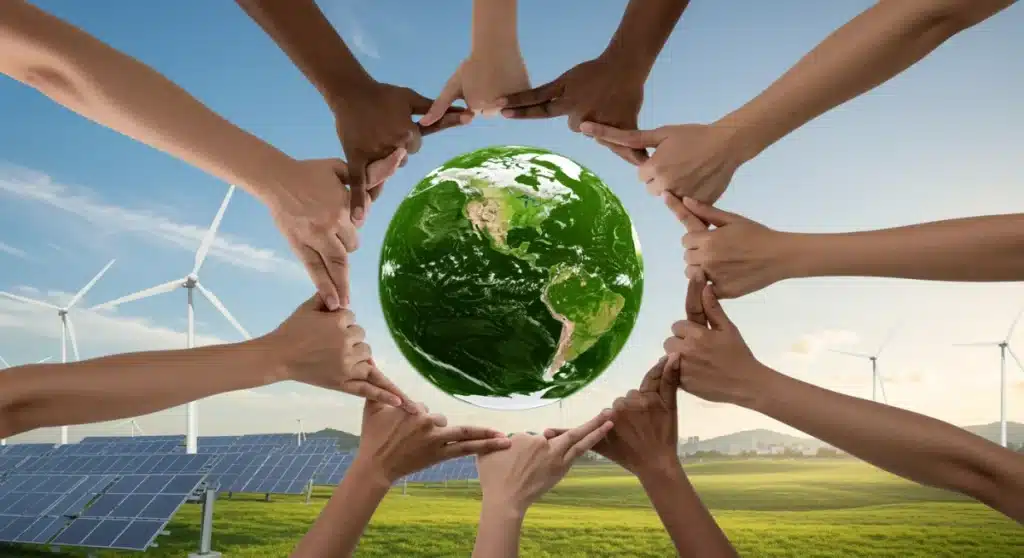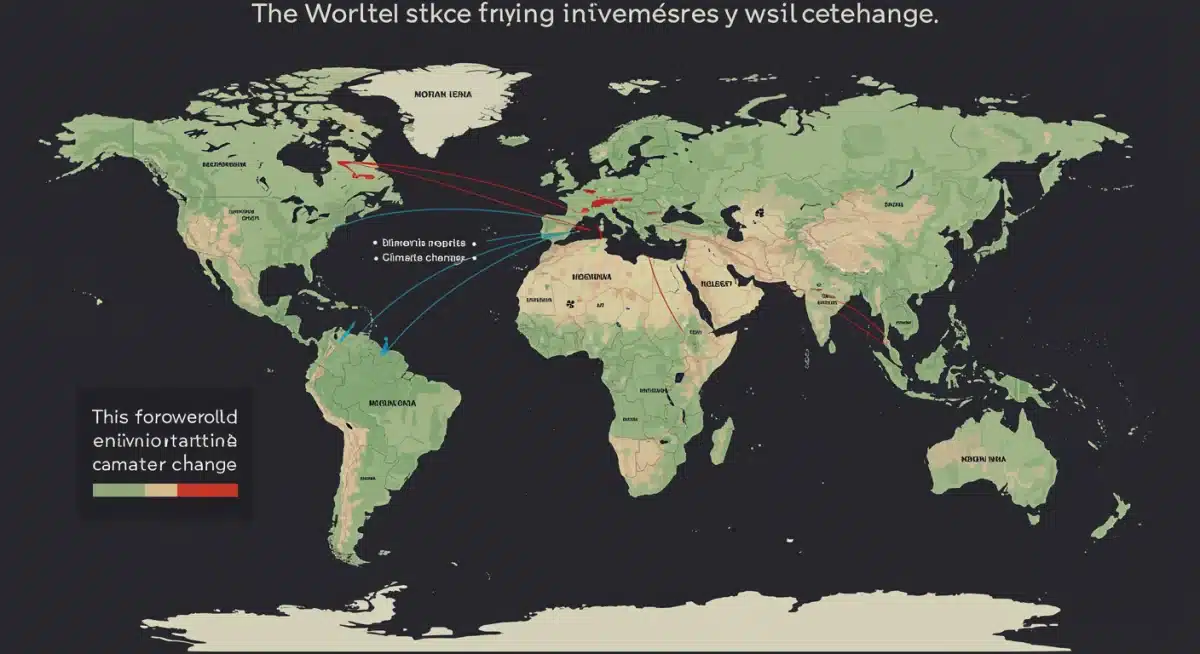New World’s Role in US Environmental Policy: Key Developments

As of late, the concept of a New World Environmental Policy is increasingly central to discussions surrounding US environmental initiatives. This evolving global landscape is significantly influencing how the United States approaches climate change, conservation, and sustainable development, demanding a reevaluation of traditional policy frameworks and fostering new avenues for international cooperation.
Defining the ‘New World’ in Environmental Context
The term ‘New World’ in environmental discussions refers to a paradigm shift characterized by heightened global interconnectedness, accelerated technological advancements, and a more urgent recognition of shared planetary boundaries. This redefinition moves beyond traditional nation-state-centric approaches, emphasizing global responsibilities and interdependencies in addressing environmental crises.
This evolving context necessitates a fresh look at how environmental policies are formulated and implemented, not just within the US but across the globe. It underscores the idea that local actions have global repercussions, and global events directly impact local environments.
Emerging Global Dynamics
The past decade has seen a rapid acceleration of global challenges, from climate change impacts to biodiversity loss. These issues transcend national borders, demanding coordinated international responses. The ‘New World’ acknowledges these cross-cutting challenges.
- Increased frequency and intensity of extreme weather events.
- Growing awareness of transboundary pollution.
- Complex supply chains impacting global ecosystems.
- Rise of non-state actors in environmental advocacy.
Technological Integration and Data Sharing
Advancements in data science, remote sensing, and artificial intelligence are transforming how environmental data is collected, analyzed, and shared. This technological integration is a cornerstone of the ‘New World’ approach, enabling more precise monitoring and more effective policy interventions.
The ability to track environmental changes in near real-time empowers policymakers with better information, facilitating proactive rather than reactive strategies. This also fosters greater transparency and accountability among nations and stakeholders.
Shifting US Environmental Policy Priorities
Against this backdrop, US environmental policy is undergoing significant shifts. Historically, US policy has often been shaped by domestic economic and political considerations. However, the ‘New World’ perspective increasingly integrates global implications and international commitments into its core priorities.
This includes a renewed focus on climate action, a push for green energy transition, and a stronger emphasis on environmental justice. The Biden administration, for instance, has rejoined the Paris Agreement and set ambitious emissions reduction targets, signaling a departure from previous administrations’ approaches.
Climate Action and Renewable Energy
The US has recommitted to aggressive climate goals, aiming to cut greenhouse gas emissions by 50-52% below 2005 levels by 2030. This ambitious target reflects an understanding that domestic action is crucial for global climate stability.
- Investment in renewable energy infrastructure.
- Incentives for electric vehicle adoption.
- Development of carbon capture technologies.
- Phasing out fossil fuel subsidies.
These policies are not just about reducing emissions; they are also about fostering economic growth in green sectors and creating new jobs, aligning environmental goals with economic development in a ‘New World’ context.
Conservation and Biodiversity
Beyond climate, the US is also re-evaluating its approach to conservation. The ‘New World’ perspective highlights the intrinsic value of biodiversity and its critical role in ecosystem services, which are essential for human well-being and economic stability.
Efforts include protecting critical habitats, restoring degraded ecosystems, and combating wildlife trafficking. The 30×30 initiative, aiming to conserve 30% of US lands and waters by 2030, is a prime example of this renewed commitment.
International Cooperation and Diplomacy
A defining characteristic of the ‘New World’ is the imperative for enhanced international cooperation. Environmental challenges, by their very nature, do not respect national borders. Therefore, effective US environmental policy increasingly relies on robust diplomatic engagement and multilateral agreements.
The US is actively participating in global forums, negotiating new treaties, and providing financial and technical assistance to developing nations to address shared environmental concerns. This collaborative approach recognizes that no single nation can solve these complex problems alone.
Multilateral Agreements and Partnerships
Engagement with international bodies like the UN, G7, and G20 is crucial. The US is leveraging these platforms to advance its environmental agenda and foster collective action. Recent summits have seen renewed commitments to climate finance and technology transfer.
Bilateral partnerships are also being strengthened, particularly with countries that are major emitters or are highly vulnerable to climate impacts. These partnerships often focus on sharing best practices, co-developing solutions, and coordinating policy responses.
Climate Finance and Capacity Building
A key aspect of international cooperation involves climate finance, where developed nations support developing countries in their transition to sustainable economies and adaptation to climate change. The US has pledged significant contributions to international climate funds.
Capacity building, through sharing expertise and technology, is equally vital. This helps build resilience in vulnerable communities and ensures that global efforts are equitable and effective, reflecting the shared responsibility inherent in the ‘New World’ paradigm.

Economic Implications and Green Growth
The transition to a ‘New World’ environmental policy is not just an ecological imperative; it is also an economic opportunity. The US is increasingly viewing environmental protection and sustainability as drivers of economic growth, innovation, and competitiveness.
Investment in green technologies, renewable energy, and sustainable infrastructure is creating new industries and jobs, positioning the US as a leader in the global green economy. This approach challenges the traditional notion that environmental protection hinders economic progress.
Innovation in Green Technology
Government funding and private sector investment are fueling rapid innovation in areas such as battery storage, advanced solar and wind technologies, and sustainable agriculture. These advancements are critical for decarbonizing the economy and achieving environmental targets.
- Development of next-generation renewable energy sources.
- Breakthroughs in sustainable materials and manufacturing.
- Expansion of smart grid technologies.
- Research into carbon removal solutions.
Job Creation and Economic Transition
The shift towards a green economy is generating a new wave of employment opportunities. From engineers and technicians in renewable energy to scientists in climate research, the demand for green skills is growing rapidly.
Policies are being designed to ensure a just transition for workers in industries impacted by decarbonization, providing retraining and support to help them adapt to the evolving economic landscape. This ensures that the benefits of the green economy are broadly shared.
Challenges and Future Outlook
Despite the momentum, significant challenges remain in fully realizing the aspirations of a ‘New World’ environmental policy in the US. These include political polarization, the economic costs of transition, and the complexities of international coordination.
Addressing these challenges requires sustained political will, innovative policy solutions, and broad societal engagement. The path forward is complex, but the urgency of environmental crises demands continued action and adaptation.
Political and Social Hurdles
Domestic political divisions often complicate the implementation of ambitious environmental policies. Public perception and stakeholder buy-in are crucial for long-term success. Education and outreach play a vital role in building consensus.
Resistance from entrenched industries and regions heavily reliant on fossil fuels also presents a significant hurdle. Policies must be carefully crafted to mitigate negative impacts and ensure equitable transitions for affected communities.
Global Geopolitical Landscape
The global geopolitical environment adds another layer of complexity. International cooperation can be hampered by geopolitical tensions and differing national interests. Building trust and common ground among nations remains a continuous effort.
Ensuring that all nations, particularly developing ones, have the resources and capacity to participate in global environmental efforts is essential. This requires ongoing diplomatic efforts and a commitment to shared responsibility.
Public Engagement and Environmental Justice
A crucial aspect of the ‘New World’ approach to environmental policy in the US is the increasing emphasis on public engagement and environmental justice. Recognizing that environmental burdens often disproportionately affect marginalized communities, policies are being crafted to address these inequities directly.
This involves ensuring that all communities, regardless of socioeconomic status or race, have equal protection from environmental hazards and equal access to decision-making processes that affect their environment. It’s about fairness and equity in environmental outcomes.
Empowering Local Communities
Efforts are underway to empower local communities to participate more actively in environmental policy formulation and implementation. This includes providing resources, fostering community-led initiatives, and ensuring transparent decision-making processes.
- Community-based monitoring programs for air and water quality.
- Grants for local renewable energy projects.
- Inclusion of local voices in environmental impact assessments.
- Support for environmental education and advocacy at the grassroots level.
By giving a stronger voice to those directly affected by environmental issues, policies become more effective, equitable, and sustainable in the long run. This bottom-up approach complements top-down federal initiatives.
Addressing Disproportionate Impacts
Historical injustices have often led to the placement of polluting industries and hazardous waste sites in proximity to low-income and minority communities. Current policies aim to rectify these disparities through targeted investments and regulatory enforcement.
The Justice40 Initiative, for example, aims to deliver 40% of the overall benefits of certain federal investments to disadvantaged communities. This ensures that the benefits of the green transition are shared equitably, reducing existing environmental health disparities.
| Key Aspect | Brief Description |
|---|---|
| Global Interconnectedness | Environmental issues transcend borders, demanding coordinated international responses and shared responsibilities. |
| US Policy Shifts | Renewed commitment to climate action, green energy, and environmental justice, integrating global implications. |
| International Cooperation | Emphasis on multilateral agreements, climate finance, and capacity building to address shared challenges. |
| Green Economic Growth | Environmental protection seen as an economic driver, fostering innovation and job creation in green sectors. |
Frequently Asked Questions About New World Environmental Policy
The ‘New World’ paradigm is characterized by increased global interconnectedness, advanced technology, and a unified recognition of shared environmental challenges, moving beyond traditional national boundaries to address issues like climate change and biodiversity loss through collaborative efforts.
The US is aligning its policies with global implications, focusing on ambitious climate action targets, investing in renewable energy, and emphasizing environmental justice. Rejoining international agreements and fostering green economic growth are key components of this adjustment.
International cooperation is central, involving robust diplomatic engagement, multilateral agreements, and significant climate finance. The US is actively participating in global forums and supporting developing nations to ensure collective action on transboundary environmental issues.
Absolutely. The ‘New World’ approach views environmental protection as an economic opportunity. Investments in green technologies and sustainable infrastructure are driving innovation, creating new industries, and generating jobs, positioning the US in the global green economy.
Key challenges include navigating political polarization, managing the economic costs of transition, and overcoming complexities in international coordination. Sustained political will and broad societal engagement are crucial for overcoming these hurdles and achieving long-term success.
Looking Ahead
The trajectory of US environmental policy within the ‘New World’ framework indicates a deepening commitment to global responsibility and sustainable development. As climate change impacts intensify and global interdependencies become more pronounced, expect to see continued emphasis on international partnerships, technological innovation in green sectors, and a stronger focus on environmental justice. The effectiveness of these policies will hinge on ongoing adaptation to new scientific understanding and the ability to foster enduring political consensus both domestically and on the international stage. Watch for upcoming legislative actions and international summits that will further define this evolving landscape.